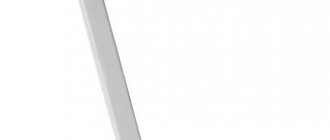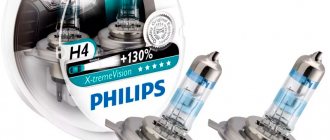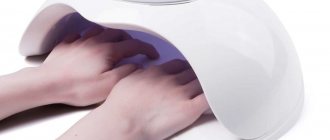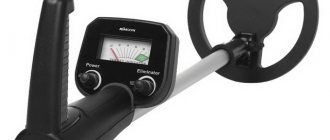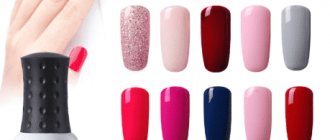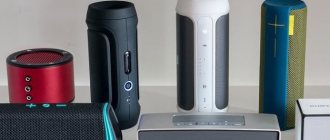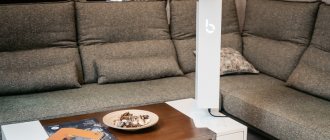| Place | Name | Characteristics in the rating |
| TOP 10 best H4 LED lamps |
| 1 | Philips X-treme Ultinon H4 | Best service life (100 thousand hours). Correct STG |
| 2 | Moonlight H4-18W | Brightness comparable to a xenon lamp. High-quality active cooling |
| 3 | STARLED H4 7Gs LED Headlight | Light filters included. Built-in driver |
| 4 | Clearlight Flex Ultimate H4 5500 | Cree LEDs. 15-year service life and one and a half year warranty |
| 5 | Narva Range Power LED H4 | The best new product of 2021. Optimal light performance |
| 6 | SVS X3 LED H3 | Using Philips LED modules. Built-in reflector |
| 7 | SHO-ME G7 lite LH-H4 H/L | Plug-and-Play installation. Flexible copper radiators. Built-in snag |
| 8 | CARCAM H4 40 W | The best type of LEDs. Housing protection. Affordable price per pair |
| 9 | i-ZOOM OPTIMA PREMIUM i-H4 | The most budget LED car lamp with imitation halogen filament |
| 10 | Vizant J1 H4 | Improved cooling system. Possibility of fixing at an optimal angle |
Comparison of H4 diode lamps with halogen and xenon lamps
By comparing the technical characteristics of different automotive lighting devices, you can see which ones are better.
Comparison of dioid and xenon light
- Power. For halogen lamps it is approximately 60 W, for xenon lamps 35 W, and for LED lamps it is 20–40 W. In terms of energy consumption, the best H4 lamps are LED.
- Light flow. Halogen lighting fixtures emit 1200–1500 lm. For xenon, this characteristic can reach 3000 lm. LED lamps H4 generate a luminous flux of 4000 Lm. Those. they shine brighter than xenon and halogen.
- Efficiency. H4 halogen lamps produce 30 Lm/W, xenon lamps - 85 Lm/W, and diode lamps - 100 Lm/W. When consuming the same amount of electricity, LED bulbs are the brightest.
- Colorful temperature. Halogen lamps emit at 2800 K (2527 °C), which corresponds to warm white light. Xenon - at 4300–5000 K (4027–4727 °C), the resulting light is perceived as daylight. A test of H4 lamps shows that their color temperature is 5000–6000 K (4727–5727°C). They emit cool white light.
- Lifetime. For lamps, it is important not only how they shine, but also their service life. Halogen lamps for cars will work for 500 hours, xenon lamps - 3 thousand hours, and LED lamps - 30 thousand hours.
If we compare all the operating parameters of H4 auto lamps, the best of them are LED lighting devices.
How to install h4 lamp
Installation of halogen pairs is simple. It does not require special knowledge or skills, but takes a few minutes. The headlight bulb will only fit in one position. How to install an LED in a headlight is described in the instructions. The pinout is clear.
Installing xenon and bi-xenon lamps requires special knowledge and skills. To do this, we recommend contacting a car service center.
When installing, do not forget that you are not alone on the road. You cannot install a light that will blind oncoming cars. Replace one with another with caution - the norms are prescribed by law. Do not under any circumstances replace halogen lamps with xenon lamps!
Which h4 low beam lamps are the best?
Which h4 low beam lamps are the best is a difficult question. After all, products are usually evaluated according to several characteristics. We tried to find out which model has the best low beam among others.
Bosch Plus 90
Plus 90 gives 1.5 times more brightness than standard. The lamps are available in three versions with different sockets: H1, H4, H7. Painted silver. This makes the Plus 90 almost invisible under the headlight. Increased distance and brightness allow the driver to see in all conditions. Cost – 900 rubles. Let's look at the advantages and disadvantages:
- The highest resource among all the standard headlight lamps discussed above.
- Excellent light output, almost twice as high as the stock base ones.
- A unique technology for directing the light beam, which is one of the most important achievements of the company.
- Warranty from the most famous manufacturer of automotive accessories and spare parts in the world.
- Highest illumination intensity, but without dazzling drivers with low-beam headlights.
- Rich white daylight.
- 90% increased light output compared to standard incandescent lamps.
- Excellent visibility and better visibility over long distances even in bad weather conditions (rain, fog, etc.).
- High quality workmanship and premium design - the silver top and blue coating create a blue flickering effect even when the headlights are off.
- There are no cons.
Bosch Plus 90
Osram COOL BLUE INTENSE H4 64193CBI-HCB 12V 60/55W
Next in our TOP are Osram COOL BLUE INTENSE lamps. Although their name refers to the presence of a cold blue glow, in practice the light turns out to be bright white with a slight yellow tint, corresponding to a color temperature of 4200 K. It is not entirely clear why the manufacturer came up with such a name, but it is worth noting that the light of such lamps is as close as possible to to natural daylight, which makes it pleasant to the eye and does not cause fatigue, unlike standard lamps. It is also worth noting that compared to standard halogen lamps, OSRAM COOL BLUE INTENSE is 20% brighter. In dry weather, the high beam illuminates the road and the side of the road very brightly and far away. True, the service life of such lamps will be shorter compared to conventional halogen lamps. With intensive use, for example, in a taxi, they last for 2-3 months. But most car owners will be able to stretch out the pleasure of using such headlights for six months or even a year. In general, if you want your car's headlights to glow with a bright white light that is pleasing to the eyes, then I recommend purchasing Osram COOL BLUE INTENSE.
- Power: 60/55 W.
- Voltage: 12 V.
- Luminous flux: 1650/1000 Lm.
- Color temperature: 4200 K.
- Min. service life: 50/200 h.
- Base: P43t.
- Dimensions: 82 x 17 x 17 mm.
Which H4 lamp is better to buy?
The main operating parameter of any lighting element is its power. Depending on the nature of the lamp’s use, this figure can vary up to 60 W. This value is sufficient to emit light over a distance of more than 100 meters without the risk of blinding oncoming drivers.
You should not install overly powerful models. This may result in melting of the main structural elements of the headlight and wiring.
An important criterion for choosing a lamp is color temperature:
- Yellow light is typical for all-weather lamps. It effectively dispels fog and does not have a negative impact on drivers of passing cars.
- For long driving in the dark, it is better to use a cooler glow, which guarantees a comfortable perception of the road for a long time.
Pay attention to the declared lamp life. For rare night trips, you should not overpay for a long working life, since 3-5 thousand hours of operation will be enough for long-term use. Providing additional lighting during the day, as well as regular operation of headlights in standard mode all night, will require a longer service life - from 10,000 hours.
Recommendations: 10 Best Smart Bulbs
14 best H11 lamps
15 best car lamps in H7 socket
H4 lamps: review of the best 2021 – 2021
Let's look at what distinguishes h4 diode lamps from others. Car enthusiasts note their low energy consumption and long service life. LEDs do not have a filament, so they are shockproof. Let's choose the best models 2021 - 2021.
- Philips X-treme Vision;
- Sho Me g7 Ih;
- Osram night breaker;
- Led headlight;
- Bosch gigalight;
- Mtf aurum.
Philips X-treme Vision
Philips X-treme Vision differs from standard beam lengths. It is 45 meters longer. This beam allows you to see holes in advance. Car enthusiasts note the quality and wear resistance of the product. X-treme Vision is a leader in its price segment. Philips h4 sold in pairs. The average cost is 1000 rubles.
- Beam length.
- Wear resistance.
- The glass allows the headlight to work after damage.
- Depending on the car model, the lighting angle may change.
I recently purchased X-treme Vision. The light output of the beam is increased, as stated by the manufacturer. But the lighting angle is very small. They didn't fit my car. Suitable for some.
Philips X-treme Vision
Sho Me g7 Ih
Sho Me g7 lh are equipped with original chips from Philips. One of the brightest compact LEDs. Light flux – 3500 Lumens. Color temperature – 5000K. The design of the model is equipped with copper radiators. Sho Me g7 Ih work efficiently for a long time, maintaining the original parameters. 4500 rubles – average price.
- Built-in deceptions.
- Wear resistance.
- Copper cooling system.
- Brightness.
- Price.
Excellent brightness! I bought it for my father for his birthday, then I bought it myself. I like everything, they work without any complaints.
Sho Me g7 lh
Osram night breaker
Osram is a company from Germany. Let us immediately note the German quality of the model and the powerful light. Visibility with night breaker is 40 meters. The distance is average, but sufficient to prevent a dangerous situation. The light of night breaker does not tire your eyes. The high beam is white, and the low beam is yellow. With these you can easily travel hundreds of kilometers. 890 rubles – approximate cost.
- The safe distance is greater.
- The eyes don't get tired.
- Suitable for dusty roads and use in fog.
- Price and characteristics.
The Germans increased the price significantly, but the quality is not much better than standard headlights. Before you buy, think about it - is it worth it? On the plus side, the distance is 40 meters, the light is brighter.
Osram night breaker
Led headlight
Led Headlight produces 0.7 times more light than halogen. This seventh generation model is easy to install in any car. Philips H4 LED lamps were installed. There are tricks in the model. Therefore, your on-board computer will never “lie”. The average price is a thousand rubles.
- Durable body made of a special alloy.
- Powerful light.
- Deceptions.
- Poor high beam.
I took these headlights because I killed the old ones. The high beam on them is not very good, and the driver jams the radio. There are advantages, but for me they are insignificant. The deceptions work.
Led headlight
Koito whitebeam
With standard power, Koito has learned to double the brightness. The Japanese manufacturer supplies 4 lamps in a set. Whitebeam light reproduces xenon headlights. This effect was achieved due to the blue bulb and silver tip. It is inexpensive - 1500 rubles.
- Your eyes won't get tired on long trips.
- Brightness.
- The headlights are blinding in the rain.
The lamps are okay, but visibility is poor in wet weather. Besides xenon, there is little good on the market. This doesn't work in St. Petersburg.
Koito whitebeam
Bosch gigalight
Headlights almost never tire your eyes. White color. Intensive. Close to daytime. The brightness of the headlights, due to the ice lamps, is 1.5 times higher than standard ones. 1000 rubles – approximate cost.
- Good visibility in the snow.
- Range of the light beam.
- They are blinded.
- Poor visibility in wet weather.
At first I liked the headlights until I drove in the rain. There is no visibility at all. If you turn up the light, oncoming cars wink to tell you to turn it off, it blinds you. I barely made it home. If you do not live in the Sahara or where it is dry and warm, I do not recommend it.
Bosch gigalight
Mtf aurum
Painted yellow, sometimes purple. They have an unusual design. Aurum shines a pleasant yellow. The eyes don't get tired. Suitable for long driving trips. Replacement takes no more than 10 minutes. Average price – 700 rubles.
- Price.
- The eyes don't get tired.
- Wear resistance.
- Low light.
When it’s raining outside, they shine better than standard ones. Everything is visible on the asphalt. Water doesn't eat up light. When it’s not raining, it’s also at the highest level. But a little dull. For this price one of the best options!
Mtf aurum
How to choose H4 LED light bulbs
In order to decide which lamps are best to use, we will consider several options. Review of H4 diode lighting devices:
When choosing LED lamps, pay attention to the power, degree of protection and light spectrum
- Car LED bulbs CL7 H4 premium. They have Philips diodes installed. H4 LED car bulbs consume 25 W of power. This is much less than halogen ones. The color temperature is 4800 K, which corresponds to daylight. The updated set of CL7 H4 LED lamps features a 15% increase in brightness compared to the previous series. The luminous flux per lamp is 1700–1900 Lm. Cl7 H4 operate on a voltage of 9–32 V. CL7 H4 LED bulbs have a service life of 5 years. Moreover, the maximum temperature to which they can heat up is 110°C. This is better than similar halogen lighting devices, which heat up over 200°C.
- The next option is the seventh generation H4 G7 diode bulbs. Testing shows that their luminous flux reaches 4000 lm. A distinctive feature of the H4 G7 is its passive cooling system. In addition to this, they have good energy performance, consuming 25 watts of power. The operating voltage for H4 G7 is 12–24 V. The color temperature is 6500 K, so G7 bulbs can be chosen by lovers of cool white light. Seventh generation LED lamps are highly efficient - 160 Lm/W. High-quality protection from external conditions is provided by a reinforced housing with IP 65.
- H4 lamps with increased luminous efficiency. One lamp, consuming a power of 30 W, emits a luminous flux of 3200 lm. Operates on a voltage of 8–32 V. Super LED is based on Osram LEDs. The color temperature of high-brightness H4 car bulbs is 6500 K, which corresponds to cool white light. Super LEDs work for 50 thousand hours.
- Car lamps H4 12V 60/55W. As the name implies, this device operates on a voltage of 12 V, the power consumption can be of two options: 55 W or 60 W. The H4 12V 60/55W lamp has an increased luminous flux. The H4 12V 60/55W car lamp is made on the basis of Philips diodes.
From the list above, you can select diode low/high beam lighting devices depending on the parameters.
Hi all. In this review I will tell you about probably the most unusual LED lamps. This time the manufacturer tried very hard and developed not only a very interesting case, but also managed to get a very good cut-off line. And this is another fairly big step by Chinese manufacturers towards the correct cut-off line.
I’ll immediately offer you a video version of the review:
I will start the review as usual with the configuration. The lamps are supplied in a small thick cardboard box with filling. The packaging looks very good, but apart from two lamps and instructions there is nothing more here. This model of lamps is sold both in pairs and individually. At the moment, lamps are only available in H4 socket.
The lamp has a very unusual aluminum body. At the bottom of which there is a fan. The fan is very small, this is the first time I have come across such small fans in lamps. Fan dimensions 21x21mm.
The design of the lamp is made in such a way that when installed in a headlight, almost all of it is located inside the headlight; only the contacts for connecting the power remain outside, like a regular halogen lamp. About a year ago I tested lamps with a similar installation method, but the back wall of the lamp had slots for air circulation, because of this dust could penetrate into the headlight from the engine compartment; this type of lamp does not have this drawback. On the bottom of the lamp there is a designation of contacts, but by and large this information is not very necessary, because H4 lamps are connected using a solid connector, which simply cannot be plugged in any other way. Although even if it works, then in this case there is protection against reverse polarity. Designations: E – general, L – near, H – far.
4 LED assemblies are used as sources of low and high beam, two each for low beam. When the low beam is turned on, the LEDs located under the curtain work, and when the high beam is turned on, the diodes located closer to the radiator work. I was only able to find out the manufacturer of the LEDs, but I could not find documentation for this type of LEDs. Manufacturer: lattice power.
Dimensions
The lamp weighs 54.3 grams. The dimensions of the lamp are shown in the following photographs.
If we compare the lamps under review with ordinary H4, then the contacts of the lamps under review do not protrude by 5 mm. Otherwise, there are no restrictions on installation, and even these 5 mm can hardly be considered any kind of limitation.
Disassembly
The lamp body consists of two halves connected to each other by two screws.
There are three printed circuit boards inside. One is the main one, the driver is installed on it. The second is a board with a copper base, LEDs are installed on it, this board is pressed tightly between the halves of the case, and for better heat dissipation in places of contact with the case, the board is coated with thermal paste. The third is an adapter board between the board with the driver and the board with LEDs. Usually a bunch of wires are used instead, using such a board greatly simplified the assembly process.
Schottky diodes labeled SK510B are installed at the input, which have reverse polarity protection. A chip with a foreign key is used as a driver. The marking of the KS7105 microcircuit, I could not find documentation for it. Nearby there are two current-setting resistors with ratings of 200 mOhm and 300 mOhm. Resistors are connected in parallel. The 300mOhm resistor shows traces of flux and soldering. These two resistors can be replaced if you are not satisfied with too high brightness or heating.
Stated characteristics:
Power consumption on low beam: 35 W Power consumption on high beam: 35 W Supply voltage: 11-30 VDC Luminous flux: 5800 Lm Color temperature: 6500 K (+-500 K) Protection class: IP67 Housing material: Aluminum 6063 Service life :>50000 hours
Consumption
Before testing, I warmed up the lamp for a while, then took measurements. The results surprised me a little. Typically, this consumption pattern is observed with unheated lamps. If there is a need to use these lamps at a higher voltage, above 18V, then you will need to slightly increase the current-setting resistor, because At such voltages an increase in power is observed. I would suggest replacing the 200mOhm resistor with a 240mOhm resistor.
Warming up
The lamp was warmed up as follows. I took a small cardboard box in which I made a hole and installed the lamp in it, similar to how a lamp is installed in a headlight. In this case, the test is quite tough, because in a headlight, the lamp is usually installed in a metal mount, which will partially act as a radiator. The lamp body heated up to 74C, but there is nothing to worry about, such a temperature cannot damage the headlight reflector; standard halogen lamps have a significantly higher operating temperature. Part of the lamp with the fan was completely inside the box, the experiment lasted 1 hour, during which time the air in the box warmed up and the lamp reached a steady-state temperature. Warming up was carried out at a voltage of 14.2V.
Yes, 120°C is not the norm, but these are the first lamps with such brightness and a normal cut-off line. The LEDs of the very first lamps with good stg that I tested heated up to 190°C; I have no reviews for these lamps. Then I tested TC-X lamps, their LEDs heated up to 163°C, but strangely enough I came across a lot of positive reviews for these lamps, there were even reviews that the lamps lasted a year and a half with daily use and remained fully operational at the time of the review. Then I came across lamps with a petal radiator; their LEDs heated up to 147°C. There were also Bi-led, but the cooling system there was made differently, so we won’t consider them. Thus, these lamps take first place among lamps with a good cut-off line.
Brightness
Measurements were taken from a distance of 1 meter from the light source to the measuring device. According to measurements, the brightness of an LED lamp exceeds the brightness of a halogen lamp by almost 2 times in low beam and almost 8 times in high beam.
Field tests
Let's aim the headlight at the garage from a distance of 5 meters. We see a smooth shelf of the cut-off line, which is visible even more clearly than on a headlight with a halogen lamp. As for the jackdaw, at the very beginning of the jackdaw there is a slight dip in illumination. By the way, unlike most LED lamps, after installing this lamp, the headlight reflector did not have to be adjusted. Usually, you first have to adjust the cut-off line by rotating the lamp in the base, and then adjust the angle of the reflector. I didn't have to adjust anything here.
Now high beam. It can be seen that the LED lamp has more directional light than the halogen lamp.
Let's direct the low beam into the distance. The difference in brightness is immediately noticeable. It can also be noted that the near zone in front of the vehicle is illuminated much better than in the case of a halogen lamp. But a small dip in illumination in the center, in the place where the cut-off line should begin, is also visible in the following photographs. If I had tested these bulbs in two headlights, as most reviews do, this failure would not be visible in any of the photographs. You can also notice that the daw of the LED lamp has a larger angle of inclination. Otherwise, the same clear cut-off line.
Now let's aim the high beam into the distance. The difference in brightness is also immediately noticeable; the area in the center with the highest brightness is visible, thanks to which the road will be better illuminated in the distance. The near zone is illuminated approximately the same as a standard halogen lamp.
As an addition, I will show the cut-off boundaries of the low beam of the best lamps I have previously tested. The lamp under review has the clearest stg line of anything previously tested.
Conclusion
It was very interesting for me to test a new type of lamps that had just appeared on sale. I give this lamp an honorable second place in my rating of LED lamps. The first place also remains with Bi-Led lenses. What I especially liked about the lamps I reviewed was that at twice the brightness, it was possible to greatly reduce the heating of the LEDs. In addition, the heating can be reduced even more and the brightness will still remain at a fairly high level. Another advantage of these lamps is the design and installation method, thanks to which the lamp is completely located inside the headlight. This lamp can be easily installed in any type of headlight with H4 socket, because... takes up exactly the same amount of space outside as a halogen lamp. The only downside I can name is the lack of illumination in the center and the biggest disadvantage of these lamps is the price.
LED lamps H4 on Aliexpress
One of the most common automotive lamps is the H4 (three-pin) socket. And here are the five best-selling models on Aliexpress.
YHKOMS h4
A set of LED lamps from the Japanese manufacturer YHKOMS with fans are perfect for operating car headlights in low and high beam modes. The model is universal and suitable for any make of car. The size of the lamp is similar in size to the filament of a halogen lamp. This guarantees correct focusing in the headlight reflector.
It is characterized by a thick radiator made of aluminum and an active type of cooling. YHKOMS h4 are built on COB chips. The calculated power value is 60 W. The luminous flux power is about 9 thousand Lumens, the voltage for a pair is 12 V. The lamps are distinguished by a simple adjustment and configuration mechanism. This is ensured by a special rotating mechanism. The LED diode is blown using an active ventilation system. Depending on the specific model, the temperature at which the fog lights shine also changes - from 3000 to 8000K. They have proven themselves well when working with high or low beam lighting.
Among the advantages of llamas, they note: they do not blind drivers of oncoming cars due to a clear light-shadow boundary; direct a powerful and even beam of light. Thanks to the IP67 protection rating, the lamps can withstand the most adverse weather conditions.
The disadvantages include the labor-intensive installation process.
YHKOMS h4 belong to the new generation of LEDs.
